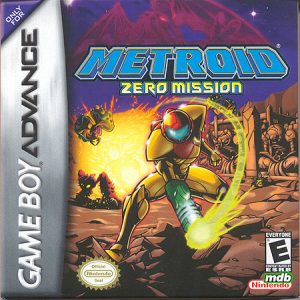 Review by: TJ Rappel
Review by: TJ Rappel
Original Publish Date: Pending
Final rating: “MZM is fun as heck and definitely a rewarding experience for Metroid vets.”
 Since movie and game creators seem to get upset when people call their remakes “remakes,” I suppose the best way of referring to Metroid Zero Mission is a “re-envisioning,” or a “re-imagining,” or…uh…ah screw it. It’s a remake.
Since movie and game creators seem to get upset when people call their remakes “remakes,” I suppose the best way of referring to Metroid Zero Mission is a “re-envisioning,” or a “re-imagining,” or…uh…ah screw it. It’s a remake.
But as far as I’m concerned, there’s nothing wrong with that. To me, remakes don’t take anything away from the original work on which they’re based. Their purpose is not to replace the original, nor to put down those who poured their hearts and souls into creating it. Rather, they’re saying hey, the original was SO good, that we decided to take its concept and explore it even further now that our technology allows us to do so. And if you don’t like it, well, nobody’s telling you that you can’t dust off your NES and fire up your old Metroid cart anymore.
That said, what I really hope for in a remake is a work which retains all the elements which made the original great, while adding enough new material to surprise and intrigue even those fans who are intimately familiar with its ancestor. In my opinion, Nintendo did a wonderful job in this respect.
Graphics
The first thing you’ll notice is sort of an American comic book art style permeating both the game itself and the artwork on and in the package. Some backgrounds have an almost Jack Kirby-esque quality to them, with lots of solid blacks and bright colors.
With a wink to the original Metroid, many graphical and design elements were retained. Even the Metroid logo on the title screen has that same pseudo-3D look, with the same color scheme of blue with orange trim, and the occasional animated sparkle fluttering along its edges, as the whole thing hovers in the starry night sky over the surface of the planet. Samus, as seen in many of the preview videos circulating on the Internet prior to the game’s release, runs quickly and with her gun arm held out — just like in the original. (One video, found for a brief period of time on Nintendo’s Japanese website, showed an early build with even more cartoony graphics, bringing back Samus’ large bubble-headed helmet, more in keeping with the style of the first game. The final version, of course, gives her more realistic proportions.)
While some elements pay tribute to the original, new additions include cutscenes (much more brief than those found in Fusion, but just as beautifully rendered), Chozo heiroglyphs, and even a new armorless Samus (we’ll get into the story behind that in a moment). Armored Samus also has a cool blue-shadow-trail effect when she jumps, for no apparent reason other than it makes her look sleeker (or perhaps as a nod back to Castlevania — since Symphony of the Night and subsequent CV games were heavily Metroid-influenced, perhaps Metroid is taking a cue or two from them as well?). The new material works well with that which is inspired by the old.
All in all, MZM continues the tradition of high quality visuals and brings Samus’ first encounter with the Space Pirates up to speed with her other 2D adventures.
Sound
No worries here, as all our favorite themes from Metroid are not only retained, but reworked and made even more hauntingly beautiful than they were on the NES. Themes from Super Metroid, including the boss battle themes, Samus’ theme, and the Crateria theme make their appearances, giving the game a nice audio tie-in to the chronologically later titles in the series.
New musical themes include the “sneaking” music found in the post-Mother Brain sequence and some spooky incidental pieces heard upon encountering directional clues from the Chozo statues and the acquisition of Unknown Items. Good stuff all.
Control
Although the control in the 1986 game seemed flawless at the time, Nintendo has continued to refine it over the span of four more 2D games. MZM boasts the smoothest control over Samus yet, with every feature found in all of its predecessors, from bomb jumping to wall jumping (more forgiving this time than in Fusion, yet still not quite as exploitable as in Super), ledge-grabbing to spring-balling. It’s fun to explore those old areas with new abilities, even if we can’t get stuck in the doors and find “secret worlds” anymore.
Gameplay
Take all of the above elements, combine them into your standard Super Metroid model, and then floor the gas pedal — MZM plays fast. The other Metroid games, as fluid and challenging as they were at the time, run at a fraction of the speed of Zero Mission. Why they decided to hasten the gameplay, I’m not sure, but I think I love it. Samus seems so much more lithe and acrobatic at higher speeds, underscoring her reputation as a badass mercenary.
For the most part, the gameplay of MZM is quintessential Metroid — if you’ve played the original and Super, you know what to expect, with none of the tweaks that Metroid II or Fusion lobbed our way. The addition of blatant hints from Chozo statues may turn off some hardcore adventurers — an option to disable this probably would have shut them up. However, some nice additions were made, such as instant energy refills attained by Morph Balling up in the hands of the statues, and new gadgets found in the labyrinths like the zip lines and Morph Ball shooters. Additional bosses have been conjured up as well, although Kraid (now as huge as he was in Super, so no more questions about his ridiculous growth spurt) and Ridley are still the main two beasts which must be dispatched to gain access to the Mother Brain.
Where the game throws us a total curve, however, is after the battle with Mother Brain in Tourian. While the original game made us escape the facility before it self-destructs and then greeted us with the ending credits, Zero Mission doesn’t stop there. As Samus escapes the planet, she is attacked by Space Pirates and her ship is shot down. Landing back on Zebes, an armorless Samus must sneak her way through the Pirates’ mothership and re-equip her powered suit, then make a daring escape. The sneaking mission is a complete departure from the rest of the Metroid series, and some may view it as a break from the action — as well as from Metroid tradition. I do agree that it feels a bit like a tacked-on epilogue, but at the point when Samus uses the Unknown Items and the link between her original Metroid 1 armor and the beefed-up Metroid 2 armor is explained, it all makes sense.
What I love about this is that Nintendo probably knew that we wanted to see the return of “armorless Samus” as featured in the original Metroid. However, Nintendo are always so sly about giving us what we want, but not in the way we’re expecting. (For example, they could have just put out a collection of old NES games on the Gamecube that would have cost them almost no money or effort, but instead they integrated all the classics into Animal Crossing and made us work for them.) By adding the stealth sequence to the end of Zero Mission, they gave us our armorless Samus again, but they also gave us a reason to play as armorless Samus. It’s that kind of thinking that sets Nintendo’s designers apart from the rest.
Overall
Strangely, Nintendo consoles have been the place to be for remakes of milestone games: the Gamecube has the spectacularly updated versions of Resident Evil and Metal Gear Solid, and the GBA has hosted the likes of Kirby: Nightmare in Dreamland (a spifftastic version of the NES masterpiece, Kirby’s Adventure) and now Metroid Zero Mission. I’m not sure what this says about Nintendo and their place in the industry, but to gamers with an appreciation for the history and fascination with the future of videogames, it’s kinda cool.
As I said earlier, MZM will never replace the original Metroid. (It doesn’t even try to; NES Metroid is unlocked after finishing ZM.) But it does take the story and fit it a bit more snugly into the canon of the series, and flesh out the original concept nicely. Significance to the world aside, though, MZM is fun as heck and definitely a rewarding experience for Metroid vets.
